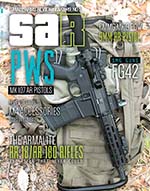Book Review: V19N5
By Dean Roxby
The M1 Garand Rifle
By Bruce N. Canfield
ISBN: 1-931464-56-1
872 pages.
2,150+ photos and diagrams, many in color.
Hard cover and matching dust jacket
8.5x11 inches,
$96.99
Published by:
Mowbray Publishing,
54 East School St,
Woonsocket, RI 02895
(800) 999-4697
www.gunandswordcollector.com
This book is an absolutely fantastic reference work. Noted military weapons author Bruce N. Canfield has delivered a true labor of love with this massive book. At 872 pages, and approximately 2,150 photographs, line drawings, and illustrations, this is the go-to reference volume for the Garand rifle. In the Foreword, Bob Seijas, co-founder and chairman of the Garand Collectors Assoc. refers to this as “The definitive work on the subject.”
Naturally, the book begins with a brief look back at weapons evolution well prior to the Garand. After the switch to the self-contained cartridge, came manual repeaters. Around the turn of the 20th century, semiautomatic civilian sporting arms began to appear. After some initial reluctance, due to concerns of ammo wastage, the U.S. Army began to consider re-equipping with a semiautomatic rifle. The first chapter, Quest for Firepower, covers this early search. Several potential candidates are examined, including the Danish Bang, the Mexican Mondragon, the Mauser Self Loading Rifle, and various other lesser known designs.
Chapter 2 introduces us to John C. Garand and documents his early prototype designs. Interestingly, these first designs (T1919, and T1920) had detachable 20- or 30-round magazines. The 8-round enbloc “pinger” is the most distinctive feature of the final M1, and is often thought of as a shortcoming; but this was actually listed as a requirement. A document from February, 1921, is reprinted that states, “...the rifle may be fed from clips. The magazine may be detachable, but this is not considered desirable.” And “...should not exceed 10 rounds.”
As well, several other contenders in the 1920 and 1921 Ordnance Tests, and 1922 Comparative Tests are shown. Besides several variations of Garand designs, these include two types of Colt-Thompson Autorifle, a modified Bang, Berthier, Pedersen, and White designs.
Once the Garand was chosen to be the official service rifle, several other inventors came forward with designs they believed to be superior to the Garand. Separate short chapters on the Johnson, Petersen, and Winchester follow. The Winchester G30 was designed by Jonathon Edmund Browning, a half-brother of John Moses Browning.
Soon after it was adopted, the Garand faced actual combat. Several chapters follow the M1 through World War II. As well, there is a short chapter detailing foreign semiautomatic service rifles, such as the Soviet Russian SVT 38 and SVT 40, the German Walther G43/K43, and even a Japanese Type 5, a copy of the Garand. Five crisp color photos show this rare rifle off wonderfully.
Chapters on specialized sniper and National Match versions, Korean War service, use in other countries, U.S. Navy 7.62x51 use, and the shameful “demilitarization” (scrapping of fully functional guns) add a great deal of interesting and useful knowledge.
Research into selective fire versions (including retrofit conversion kits for existing M1 rifles) and detachable magazine versions as well as other post-war rifles are covered in Research & Development 1945-1950.
There are all sorts of little tidbits of Garand related info covered, ranging from the ubiquitous B&W WW2 factory girl photos, to a brief write-up of the Kent State Ohio event, and even photos of Lee Harvey Oswald’s Marine Corp score book. In the Post World War Two chapter is mention of “canning,” long term storage of firearms in sealed drums. Imagine finding ten new Garands in a sealed drum now!
Of particular interest to collectors is the section entitled Accessories and Accouterments. This section alone is 120 pages, so all manner of related items are covered. It is quite astounding to see what is out there.
The Components chapter is a very useful section for comparing the evolution of parts from early to late manufacture. Various bits such as the trigger housing, trigger guard, safety, etc., were simplified or otherwise changed throughout the life of the gun. This section helps to sort out the early from later versions. It is worth noting here that while this book does contain a huge amount of information, it is not a shop manual. It does not instruct the reader on how to service or rebuild a rifle. Nor does it claim to. This is not a complaint, but something to be aware of.
One small issue that could have been done differently is the tendency to refer to something in passing, then say, “This will be discussed later in this book.” but not give a page number to refer to. With close to 900 pages to sift through, this would have been a welcome feature. Aside from this one minor detail, I recommend this book without hesitation.
This article first appeared in Small Arms Review V19N5 (June 2015) |
| SUBSCRIBER COMMENT AREA |
Comments have not been generated for this article.




